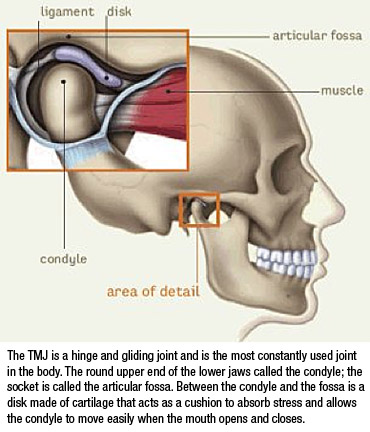The Temporomandibular Joint (TMJ)
 The temporomandibular joint (TMJ) is a small joint located in front of the ear where the skull and lower jaw meet. It permits the lower jaw (mandible) to move and function.
The temporomandibular joint (TMJ) is a small joint located in front of the ear where the skull and lower jaw meet. It permits the lower jaw (mandible) to move and function.
TMJ disorders are not uncommon and have a variety of symptoms. Patients may complain of earaches, headaches, and limited ability to open their mouth. They may also complain of clicking or grating sounds in the joint, and may feel pain when opening and closing their mouth.
What Causes TMJ Disorders?
Determining the cause of a TMJ problem is important, because it is the cause that guides the treatment.
Patients under stress frequently clench or grind their teeth at night causing painful spasms in the muscles and difficulty in moving the jaw. This is the most common cause of TMJ facial pain. Patients who clench or grind their teeth over long periods of time can cause damage to the joint, or dislocation of the disk that is located between the lower jaw and the skull. A displaced or deranged disk may produce clicking or popping sounds, may lead to pain with opening and closing of the mouth, and may inhibit the ability to open the mouth. The disk can also develop a hole or perforation, which can produce a grating sound with joint movement.
Arthritis, or inflammation of the joint, is a result of damage caused by trauma or excessive clenching and grinding. There are also conditions such as rheumatoid arthritis that can cause the parts of the TMJ to fuse, preventing jaw movement altogether.
In some patients, the pain may be due to a combination of muscle and joint problems. That is why diagnosing TMJ disorders can be complex and may require different diagnostic procedures.
 The Role of the Oral and Maxillofacial Surgeon
The Role of the Oral and Maxillofacial Surgeon
When symptoms of TMJ trouble appear, Dr. Clark, Dr. Cole, or Dr. Patel should be consulted. As specialists in the areas of the mouth, teeth and jaws, Dr. Clark, Dr. Cole, and Dr. Patel are able to correctly diagnose the problem.
Special imaging studies of the joints may be ordered and an appropriate referral to another specialist or to a physical therapist may be made.
Range of Possible Treatment
TMJ treatment usually starts with conservative care such as a soft diet, application of heat to the affected joint, short-term non-steroidal anti-inflammatory drugs, a muscle relaxant, splint therapy, and stress management counseling.
If non-surgical treatment is unsuccessful or if there is clear joint damage, surgery may be indicated. Surgery can involve either arthroscopy (the method identical to the orthopedic procedures used to inspect and treat larger joints such as the knee) or repair of damaged tissue by a direct surgical approach.
Once TMJ disorders are correctly diagnosed, appropriate treatment can be provided.
